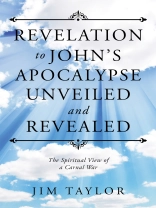There are many people, even Christians, who will not read Johns revelation letter for two reasons. First, they dont believe that it can be understood. Second, they are terrified of even thinking about reading of the deadly judgments of God that Johns revelation letter portraysthat is, the appalling plagues, famines, wars, and natural disasters that Johns letter discloses as having been pronounced against this present evil world, and they dont want to be any part of that, nor do they even want to be reminded of those dreadful things that they think are going to happen. Such is so sad, so very sad! One of the purposes of this book is to alleviate that fear completely, and to replace it by making the reading of Johns revelation letter a time of comfort and encouragement. That shall all be accomplished by illustrating how the deadly forces of destruction that John described in his revelation letter are not decreed against the Christiansthey will never fall upon Gods churchbut rather, they are in fact, the very powers of God that protect his church, shelter his children, and defend the Christian faith.
All of that can be established by comparing the spiritual war that John witnessed in heaven with the carnal war that was fought between the Roman Empire and the church. That comparison is not difficult to establish, because both of those wars were actually the one and the same war. Once that correlation has been confirmed, Revelation becomes a letter of comfort and security, and a letter that replaces fear with hope.
Another reason that even Christians will not read Johns revelation letter is because they do not think that it can be understood because it is so complicated, but God does not put books in his Bible that cannot be understood. Johns revelation letter can be understood, and that is the other purpose of this book, to make it understandable.
Despre autor
Jim Taylor is the author of this book. However, a considerable part of this book consists of the writings of an author who lived and wrote some 250 years ago. His name is Sir Edward Gibbon (1737–1794). Mister Gibbon wrote The History of the Decline and Fall of the Roman Empire, and it is his history that makes up a considerable part of this book. All credit for this book must be given to him, because a great portion of this book is composed from his classic history of the decline and the fall of the Roman Empire.
Jim and Judy married at a young age—Jim was twenty, and Judy was seventeen. Almost immediately thereafter, Jim went into the Air Force. He was on Okinawa and in Japan and China for some time. When he was discharged from the Air Force, he attended the University of Colorado as a math major. He worked for a division of Litton Industries, a company that manufactured components for guidance and control systems for aircraft and spacecraft, such as the LEM and the APOLLO. (All of the electronics Jim worked on are now in a museum, literally—it is called the Smithsonian.)
Jim was the chief inspector for quality assurance, and his job was to write the electronic test procedures by which the units were to be tested, and to supervise the testing of them to assure they met the specifications. If there was a failure, his job was to find the problem and fix it, and to take the measures necessary to prevent it from reoccurring. If by chance a unit was sent into the field that did not function properly, the company sent him out to the client to find and fix the problem. It was a very high-stress job, and so Judy and Jim decided to attend the SIBI Bible School in Lubbock, Texas. After graduation Jim became a minister for the Church of Christ where he thought there would be no stress and fewer problems.
When Judy and Jim graduated from the school they moved back to their home state of Colorado, to the little mountain town of Poncha Springs, where there was no church. Their intention was to stay there long enough to build one, and failure was not an option. They stayed in Poncha Springs for twenty-four years, and from there they moved to Mazatlán, Sinaloa, Mexico, to help build the church in that great city. They started with about four members, including themselves, and some eighteen years later there were about seventy members.
The church in Poncha Springs helps sustain the church in Mazatlán by supporting the preacher, and by buying food and necessary things for the members who are so very poor. The Mountain View Church of Christ in Buena Vista, Colorado, also helps support the church in Mexico in the same ways.







![Copertina de Brian Schrag & Julisa Rowe: Community Arts for God's Purposes [Chinese] 貼近神心意的社群藝術 Copertina de Brian Schrag & Julisa Rowe: Community Arts for God's Purposes [Chinese] 貼近神心意的社群藝術](https://static.worldofdigitals.com/thumb_webp/740/9781645083740.webp)




